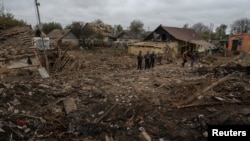On May 1, the Russian Defense Ministry reported on Telegram that a series of overnight missile attacks targeted and destroyed Ukraine’s military facilities “in more than 109 districts.”
With no evidence to back its data, the ministry claimed that during the previous 24 hours, Russian missiles destroyed 64 combat targets, killing more than 525 Ukrainian troops and destroying 87 artillery units, two ammunition depots, and more than a dozen tanks, armored vehicles and drones.
The ministry omitted information about civilian casualties.
“Tonight, the Armed Forces of the Russian Federation carried out a series of missile attacks with long-range precision air and sea-based weapons against the military-industrial complex of Ukraine. All targets were hit and destroyed,” it said.
That is misleading.
Russia’s nighttime attack against Ukraine reportedly hit residential areas. Russian missiles killed two civilians and injured more than 40 others, and damaged and destroyed schools, hospitals and hundreds of homes. The attack caused an explosion at the Pavlohrad Chemical Plant, threatening an environmental disaster.
Ukraine said Russia launched 18 missiles, 15 of which the Ukrainian Air Defense intercepted and destroyed. The Washington, D.C.-based Institute for the Study of War (ISW) confirmed Russia’s large-scale missile attacks against Ukraine on the night of April 30-May 1.
According to the Ukrainian air force, Russian strategic aircraft — nine Tu-95 and two Tu-160 strategic bombers — launched 18 Kh-101 and Kh-555 air-launched cruise missiles from the Murmansk and Caspian regions.
The Russian missile attacks targeted Ukraine’s capital, Kyiv, and the eastern city of Pavlohrad, in Dnipropetrovsk Oblast. Serhii Popko, head of the Kyiv city administration, said all missiles fired at the capital had been intercepted and destroyed.
But the city of Pavlohrad reportedly suffered a direct hit by three Russian missiles.
Ukraine’s Dnipropetrovsk Regional Military Administration reported that the Russian attack killed two civilians and injured 48, including six children.
Responding to the attack, Ukrainian President Volodymyr Zelenskyy said, “The terrorist’s missiles took the lives of two people, very young boys. More than 40 women, children, men have been treated for injuries and trauma.”
People suffered bruises, fractures, incised and lacerated wounds, contusions and poisoning by combustible material. More than 600 people filed statements with the police on damaged or destroyed property.
The Dnipropetrovsk region's Vidkritii television channel reported that a fifth of Pavlohrad’s territory was damaged by the Russian missiles. That includes 110 multi-story buildings, 93 family homes and 63 infrastructure facilities, including schools, hospitals and stores. Property damage ranges from broken windows to destroyed homes.
GeoConfirmed, a community-based geolocation platform, analyzed photos and videos of the explosions in Pavlohrad and found that at least one of the rockets hit the chemical plant.
The plant has long been known as a storage site for Soviet-era rocket fuel and components, a remnant of the collapse of the Soviet Union. More than 1,800 tons of old rocket fuel remained stored there as of January 2020.
Leonid Shiman, the plant’s general director, said the plant had no financial means for the fuel’s safe disposal.
Shiman told BBC News Ukrainian that the plant's massive amount of fuel poses an economic and environmental hazard to the Pavlohrad region and that, in the event of an emergency, “[i]t will take almost 80 years to restore the ecosystem, and about 14 to15 years to restore the economic situation in Pavlohrad.”
On May 2, Serhii Lysak, head of the Dnipropetrovsk Regional Military Administration, said the Russian missile attack on the plant did not create a threat of chemical pollution.
"Atmospheric air measurements testify to the absence of chemical and environmental hazards. But I am sure that the Russian army knew where to aim. They understood the consequences such actions could cause," he said.
The ISW noted that lately, Moscow has been more active than ever in reporting its missile strikes against Ukraine, part of a strategy to divert attention from the problems Russia is facing at the front.
Citing a White House assessment from May 1, ISW reported that in the three months since January, “Russian forces have suffered some 100,000 casualties— 80,000 wounded and 20,000 killed” — in the battle for Bakhmut alone.





